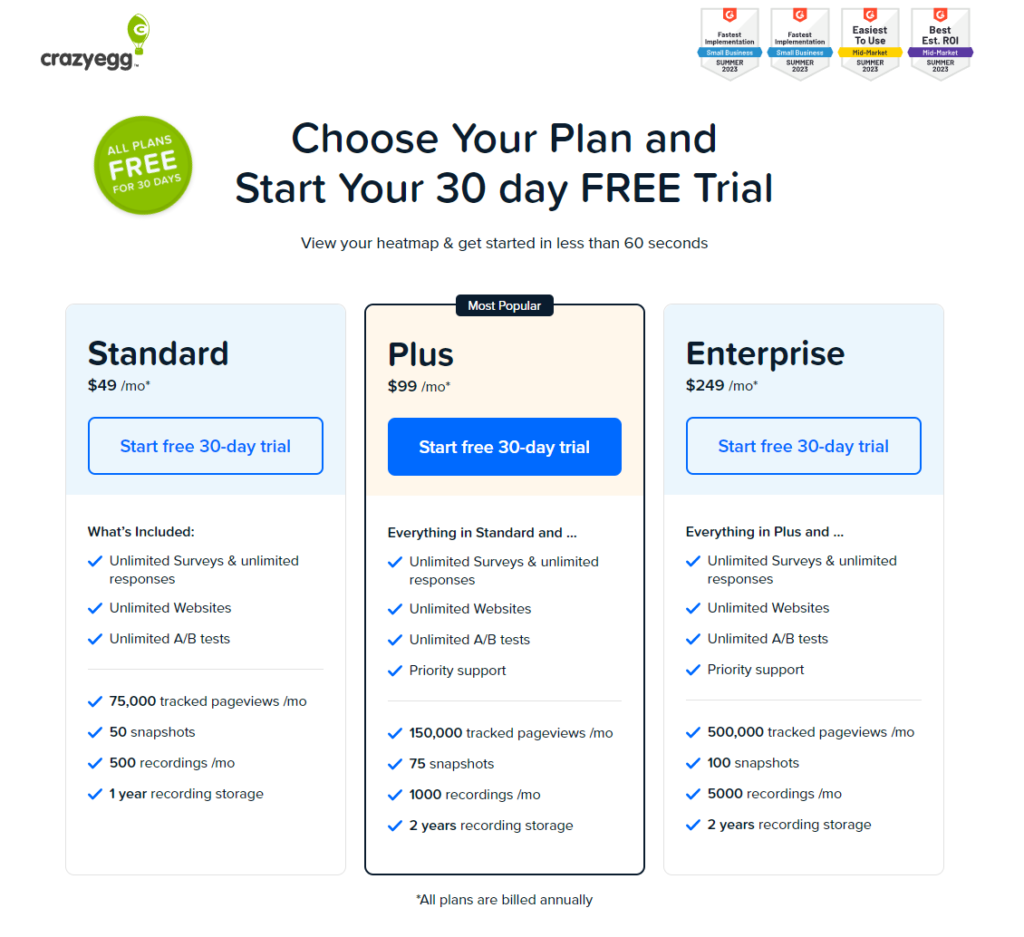In today’s fast-paced digital landscape, understanding your website’s user experience is not just an advantage—it’s a necessity. Enter the arena of digital analytics tools, where Crazy Egg and Hotjar stand out as two of the heavyweight champions. Each offers unique insights into how users interact with your site, but choosing between them can feel like navigating a labyrinth. Are you ready to discover which tool holds the key to unlocking your website’s full potential? Let’s dive into the heart of this comparison, focusing on a critical aspect that every website owner values: Heatmapping and User Behavior Analysis.
Crazy Egg | Hotjar |
|---|---|
| G2 Score – 4.2 out of 5 stars | G2 Score – 4.3 out of 5 stars |
| TrustRadius Score – 7.6/10 | TrustRadius Score – 8.2/10 |
Heatmapping and User Behavior Analysis

At the core of both Crazy Egg and Hotjar’s offerings is their ability to visually represent user behavior through heatmaps, scroll maps, and other interactive tools. These visual analytics provide an intuitive understanding of how visitors engage with your site, highlighting areas of interest, potential frustrations, and opportunities for optimization. But how do Crazy Egg and Hotjar compare in delivering these insights?
Crazy Egg: The Pioneer of Heatmapping

Crazy Egg has long been synonymous with heatmapping technology. As one of the pioneers in this space, it offers a robust suite of visualization tools designed to give website owners a clear picture of user engagement. Crazy Egg’s heatmaps show where users click, helping identify what captures their attention or where they might be getting stuck. Scroll maps reveal how far down the page visitors are willing to scroll, providing insights into content placement and page length effectiveness.
Beyond traditional heatmaps, Crazy Egg also offers Confetti and Overlay reports, which break down clicks by referral sources, search terms, and other criteria, offering a deeper dive into user behavior segmentation. These tools make Crazy Egg particularly powerful for businesses focused on understanding the ‘why’ behind user actions and optimizing their site layout and content strategy accordingly.
Hotjar: Comprehensive User Insights Beyond Heatmapping

While Hotjar also offers heatmapping capabilities, its strength lies in the comprehensive suite of tools it provides for understanding user behavior. In addition to click and scroll heatmaps, Hotjar includes move heatmaps, which track mouse movement, offering insights into how users navigate and what might be drawing their attention before they click.
Hotjar sets itself apart with its emphasis on user feedback and interaction. Tools like session recordings give a real-time view of user journeys, while feedback polls and surveys directly engage users to provide qualitative insights. This blend of quantitative and qualitative data collection enables Hotjar users to not only see how their site is used but also understand the reasons behind user behaviors and preferences.
User Feedback and Interaction Tools

When selecting the best analytics tool for your needs, understanding how each platform enables you to collect and analyze user feedback is key. Crazy Egg and Hotjar both offer powerful insights into how users interact with your website, but they also provide different tools for gathering direct user feedback, which can significantly enrich your data and help tailor your user experience improvements.
Crazy Egg:

Crazy Egg has primarily focused on providing visual analytics tools such as heatmaps, scroll maps, and session recordings. These features offer a deep dive into what users are doing on your site—where they click, how far they scroll, and how they navigate through your pages. While Crazy Egg excels in showing you what actions users are taking, it traditionally offers less functionality when it comes to directly asking users why they take those actions. For businesses looking for in-depth behavior analytics with a visual emphasis, Crazy Egg provides compelling insights into user interaction patterns.
Hotjar:

Hotjar, on the other hand, not only offers similar visual analytics tools, including heatmaps and session recordings, but also places a strong emphasis on collecting user feedback directly. Hotjar’s feedback and interaction tools, such as on-site surveys and feedback widgets, allow you to ask users directly about their experience on your site. This direct line of communication opens up opportunities to understand the context behind user actions, gather qualitative insights, and make informed decisions based on actual user feedback. For businesses that value a combination of visual analytics and direct user insights, Hotjar presents a comprehensive solution for optimizing website usability and enhancing the user experience.

Related: Check out our free SEO suite

Customer Feedback and User Surveys

This area is key for businesses that not only want to observe user behavior but also to understand the motivations behind those actions directly from the users themselves.
Both Crazy Egg and Hotjar recognize the importance of integrating user feedback mechanisms with analytics to provide a more holistic view of the user experience. However, they offer these capabilities in distinct ways that can influence your choice depending on your needs for direct user insights.
Crazy Egg:

Crazy Egg primarily focuses on visual analytics tools like heatmaps, session recordings, and A/B testing to understand user behavior. While it excels in these areas, offering intuitive and actionable insights, its direct capabilities for gathering user feedback and conducting surveys are not as central to its platform. Users looking to integrate surveys and feedback forms with Crazy Egg analytics might need to rely on third-party tools or integrations. This approach can work well for businesses that already have preferred tools for customer feedback but are looking for advanced visual analytics to complement those insights.
Hotjar:
Hotjar, on the other hand, positions itself as a comprehensive tool for understanding user experience, incorporating direct user feedback mechanisms as a core component of its platform. Alongside heatmaps and session recordings, Hotjar offers built-in feedback widgets and survey tools that can be easily added to your site. These tools allow you to collect qualitative data directly from users, providing insights into what they think and feel about your website or specific features. This direct line of communication with users is invaluable for businesses focused on user-centered design and continuous improvement based on user input.
Hotjar’s feedback and survey tools are designed to be as user-friendly and flexible as the rest of its analytics suite, making it easy to customize questions and target specific user segments or pages on your site. This integration of qualitative feedback with quantitative analytics provides a powerful combination for businesses aiming to deeply understand and optimize the user experience.
Platform Ecosystem and Integrations

In today’s digital landscape, the most powerful analytics tool is one that doesn’t operate in isolation but complements and enhances your existing suite of tools—whether it’s your content management system (CMS), customer relationship management (CRM) software, email marketing platforms, or e-commerce solutions.
Crazy Egg:
Crazy Egg offers integrations with a variety of website builders and CMS platforms like WordPress, Shopify, and Squarespace, making it relatively straightforward to implement on most websites without needing extensive technical expertise. These integrations are focused on ensuring that users can easily deploy Crazy Egg’s tracking code and start collecting data quickly. Beyond these, Crazy Egg also supports connections with optimization and A/B testing tools, aligning with its strength in providing actionable insights for website improvement. However, its ecosystem might not be as extensive when it comes to deeper marketing or sales platform integrations, which could be a consideration for businesses looking for a more interconnected analytics solution.
Hotjar:
Hotjar, in contrast, emphasizes a broader integration capability, supporting not just website and e-commerce platforms but also tools across the marketing and product development spectrum. Hotjar’s integrations extend to work with project management tools, feedback and support systems, and even analytics and data management platforms. This wide range of integrations allows businesses to weave Hotjar’s insights into various stages of the customer journey and product lifecycle, enhancing the overall strategy with a deep understanding of user behavior and feedback.
Moreover, both platforms offer API access for custom integrations, providing the flexibility to tailor the analytics solution to fit unique business needs and workflows. This aspect is particularly valuable for businesses with specific integration requirements or those looking to build a highly customized analytics ecosystem.
Pricing and Scalability

The cost of an analytics tool, alongside its ability to grow with your business, plays a significant role in the decision-making process. Balancing the investment against the tool’s features, capabilities, and the value it brings to your business is key. Crazy Egg and Hotjar both offer tiered pricing models that cater to businesses of different sizes, from small startups to large enterprises. However, the specifics of their pricing structures and how they scale with your business needs can influence which tool is more suitable for your specific situation.
Crazy Egg:

Crazy Egg provides a straightforward pricing model that’s based on the number of page views your site receives and the number of active pages you wish to track. This model makes it easy for businesses to understand and predict their costs relative to their web traffic. Crazy Egg’s plans start with a basic tier, suitable for smaller sites looking to gain insights into user behavior without a significant investment. As your needs grow, Crazy Egg offers higher tiers with additional features such as more active pages for tracking, longer data storage, and additional team member accounts. This scalability ensures that Crazy Egg can accommodate growing businesses, but it’s essential to consider whether the features provided at each tier match your evolving analytics needs.
Hotjar:

Hotjar, on the other hand, also offers a tiered pricing strategy but emphasizes its suite of tools for both analytics and feedback at every level. Hotjar’s pricing is designed not just around page views but also includes the depth of features available, such as the number of surveys and feedback widgets you can deploy. This approach means that even at lower tiers, users have access to a comprehensive set of tools to not only analyze but also engage with their audience. Hotjar’s model is particularly appealing to businesses that value direct user feedback alongside traditional analytics. As with Crazy Egg, scalability is built into Hotjar’s pricing, but with an added emphasis on feedback tools scaling alongside analytics features.
Conclusion
In wrapping up our exploration between Crazy Egg and Hotjar, we’ve navigated through the crucial aspects that dictate the choice of an analytics tool suited to enhancing and understanding your digital presence. From dissecting user interaction insights, integration capabilities, pricing nuances, and customer support to ease of implementation and platform ecosystem compatibility, both Crazy Egg and Hotjar emerge as leaders in the digital analytics space, albeit catering to different needs and preferences.
Crazy Egg is celebrated for its ability to demystify user behavior on websites through its robust visual analytics tools like heatmaps and session recordings. It’s particularly favored by those seeking straightforward insights to optimize web design and content strategy efficiently. With an emphasis on ease of use, Crazy Egg appeals to small and medium businesses looking for a quick, uncomplicated way to dive into analytics without a steep learning curve.
Hotjar, with its comprehensive suite, offers a broader lens on understanding user behavior by combining quantitative data from heatmaps and recordings with qualitative feedback through surveys and widgets. This blend makes Hotjar a valuable tool for businesses committed to a deeper dive into user experience, aiming to craft strategies informed by a rich tapestry of user insights. It stands as the go-to for entities that prioritize a holistic view of user engagement, woven into the fabric of their product development and marketing efforts.
Read Next:
- Mailchimp vs SendinBlue: The Best Email Marketing Tool for 2024
- ConvertKit vs Moosend: The Best Email Marketing Tool for 2024
- ActiveCampaign vs EmailOctopus: The Best Email Marketing Tool for 2024
- AWeber vs EmailOctopus: The Best Email Marketing Tool
- GetResponse vs eSputnik: The Best Email Marketing Tool for 2024





















Comments are closed.